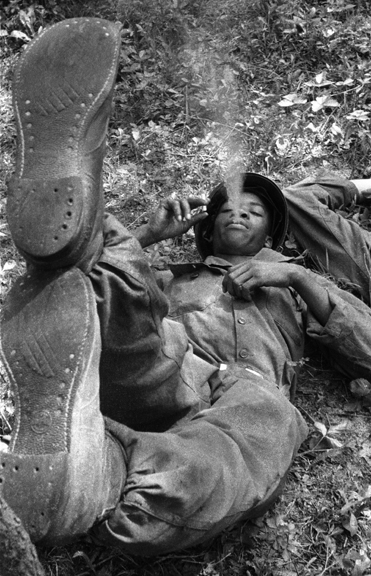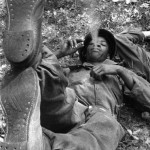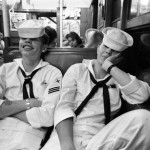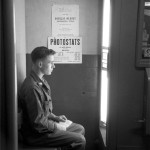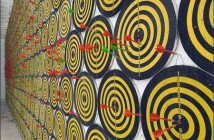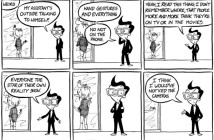A CONVERSATION WITH HAROLD FEINSTEIN
Forty-Five minutes north of Boston lives an amazing photographer. Far from the shores of Coney Island, a place that he frequented and photographed for more than fifty years, a new resurgence in the early black & white work of Harold Feinstein has evolved. Recently I had the privilege of sitting down with him at his home for this interview.
-
Jason Landry: Do you remember the exact moment in your life that you knew that you wanted to be a photographer?
Harold Feinstein: When I looked through my neighbor's Rolleiflex camera. My first thought was, "This was easy." And that was it. I was about 15 years old.
JL: I had read that by the time you were 19 or 20 you had met Edward Steichen and he began collecting your work. How did that come about?
HF: I just went to see him at the Museum of Modern Art (MoMA) and it wasn't a complex of a situation as it is now. Later on I read that he got the idea from Alfred Steiglitz that when they met a promising young photographer they would buy two or three of their works as an encouragement, which certainly it was. Soon thereafter, Steichen was getting together work for The Family of Manexhibition. He invited me to be in it and selected seven or so images to be included. At that time, I was very puritanical and I said, "Look, a museum is a place where they should just show work because it is art, not because it fits I to a theme." And so I withheld my work.
JL: You spent over five decades photographing Coney Island. What was the initial attraction that brought you to making this body of work?
HF: I often feel like I fell out of my mother's womb onto the beach on Coney Island with a Nathan's hot dog in my hand with the sounds of kids screaming on the cyclone. I just always loved that place as a kid way before I was doing photographs. It's loaded with people, and people are my favorite trees. My father would give me 35 cents on a weekend. I would take the trolley, which cost 3 cents for youngsters. And of course I'd blow it all in 10 minutes. I started drawing portraits of people on the boardwalk for 15 cents each. This would build up more money, but I would blow that too of course. So then I'd have to hitch on the back of a trolley to get home.
JL: The image of the group of Coney Island teenagers lying on the blanket with a radio is a favorite of mine. There is something seductive about the gaze of the girl with her finely plucked and stenciled eyebrows. I know we're going back 60 years, but what was your most memorable story from the Coney Island series?
HF: For one thing, people lying on the beach would say, "Hey Mr., take my picture, take my picture." So I would.
JL: So it was more proactive, than reactive?
HF: I guess so, but that's a big word for me. With Coney Island, it was a continuous process.
JL: I was watching a photo documentary recently on the Ovation channel and you were interviewed as being an assistant to W. Eugene Smith. Did his World War II images influence or inspire you to want to document the Army Draftees?
HF: No. But him as a man I loved. The main thing was he loved Teacher's Scotch and I introduced him to a lower priced scotch and so that made life a lot easier for him.
JL: In your opinion, do you think that the responsibilities of today's war photographers covering events in Iraq are similar or different than when you documented events in Korea?
HF: When I was in Korea, I wanted to go wherever the war wasn't. My main war story was that I had an ingrown toenail when I was sent to the front. And it was serious... it hurt like hell. They shipped me down to Pusan to be treated. That week they were paining the ward where I was in, so they shipped us to Kyoto, Japan. Once I was in Kyoto, before going back to Korea they gave me my records with my military occupational specialty numbers on it. I changed the number from Infantry to what I thought was Photographer. However, the number that I chose was for Illustrator. It was perfect. My company commander would make me paint signs for the battalion commander and so on. Nobody knew where I was half the time, and all I did was carry around a t-square and some paintbrushes. I ended up meeting this wonderful Korean woman and moving in with her for most of the war.
JL: Is there an image from the Army Draftee series that sticks in your mind more than others?
HF: I'm in the process now of assembling my old black & white work. There are so many images that I love. The primary activity in the Army is waiting. There is one image in particular where there is one GI lying on the ground with his feet propped up and I'm right at his feet looking down at him as he's smoking.
JL: Turning to something more recent, you've embraced the digital capture in your new work. Are you happy with how the photography medium has evolved?
HF: I love the digital world. I was considered a master in the darkroom, but you couldn't get my ass in the darkroom if you forced me to. I love being able to sit in front of a screen and darken and lighten images and edit them in a lit room. It's not the answer that purists want to hear.
JF: Was there any photographer that you ran into back in the day that wasn't so nice?
HF: There was a show at MoMA called '70 Photographers: Look at New York' and I was one of them. This guy Arthur Fellig walked over towards me, you might know him as Weegee, he said, "Hello... I am the greatest photographer in the world." And of course I didn't say it, but I thought I was. I have a lot more respect for him now then I did then. I feel he did do extraordinary work, but I had an attitude then, and I still do.
JL: What is the most important lesson today's photography student or emerging photographer should know?
HF: When your mouth drops open, click the shutter. That will lead you to your particular way of seeing. That's what it's about. Being free enough to trust your inclination to trust an impulse and just go with it.
- Harold Feinstein, Cigarette Break, 1952
- Harold Feinstein, Sailors On The Subway, 1947
- Harold Feinstein, Draftee Photo Booth, 1952
Harold Feinstein is represented by Panopticon Gallery in Boston. More of his work can be seen at haroldfeinstein.com and on his Facebook Fan page.
All images are courtesy of the artist and Panopticon Gallery.

